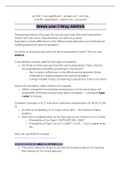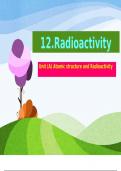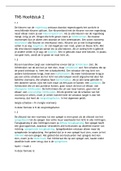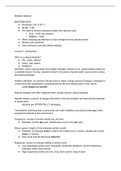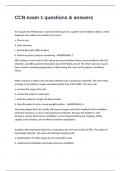Agnes
Tutorial 2
Cybele Atme
Assignment 2
Due on 20/05/20
Word count: 2178
An Investigation into South Africans’ Concern of Poverty
The priority of a country’s citizens should always be important to a government. After all,
if the citizens are unhappy with actions taken by their government, the government is unlikely
to retain their power. One way to assess citizens’ priorities is through surveys. Naturally, this
data can also be used for other purposes, such as academic research. This essay looks into a
survey conducted by Afrobarometer in South Africa. The aim is to assess the quality of the
data collected in the survey, to see if South Africans are significantly more or less concerned
with poverty/destitution than citizens of other African countries, and finally to see what the
relationship between age and concerns of poverty is among South Africans.
Before analysing the data, it is important to evaluate the research itself. The design of the
research is cross-sectional, a type of research design that analyses a “sample, or cross-section,
of a population at a single point in time” (Halperin and Heath 2017: 151). The research
investigates variation between people in the same place but does not consider change that
may occur over time. Hence, from this data, one should be careful about drawing conclusions
on how trends and patterns may evolve over time. However, it is possible to do a second
cross-sectional study to investigate how elements may have changed since the first study, in
effect adding a longitudinal aspect to the design (idem: 152). The biggest disadvantage to this
type of research is that no individual development for participants can be measured (idem:
153). However, up until this point, the aim of the research has not been to measure
development in individuals or trends and hence these disadvantages do not factor into the
research.
For this survey the unit of analysis is individuals. The study looks at characteristics of
individuals, such as age or immediate societal concerns, which can then be compared to those
1
, same characteristics of other individuals in the same area. Later in this essay, however, a
comparison between a characteristic of the South African sample and a pan African sample is
made, in which the unit of analysis will be groups. What we can derive from this is that
multiple units of analysis may be used within the analysis of one study, and largely depends
on what we are attempting to draw conclusions on.
The method of sampling used to collect data is another crucial aspect of research.
Afrobarometer themselves state that, at every stage of sampling, they make use of random
selection methods and ensure that the probability of a participant being chosen is
proportionate to their area’s population size (Afrobarometer 2015a). Their sampling universe
is comprised of all citizens who are eighteen years old or older, but often does not include
individuals in institutionalized settings (ibid). It is further specified that the sampling process
is done in four to five steps: 1) in rural areas secondary sampling units are drawn (this is not
done in urban areas), 2) primary sampling units are selected, 3) sampling start points are
randomly selected, 4) households are randomly selected by interviewers, and 5) the
interviewer randomly selects a respondent in the chosen household – between each
household the interviewer will alternate between interviewing females and males (ibid). The
use of surveys is valuable to investigate a wide range of topics within one study and, if the
sample is representative of the population, can provide us with reliable information (Halperin
and Heath 2017: 159). If the sample is not representative of the population a researcher will
be unlikely to be able to make accurate generalisations based on the data (ibid). However,
Afrobarometer seem to ensure that their samples are chosen entirely randomly, from which
it can be concluded that the data they have collected is of sufficient quality.
The calculations below will be based on two variables from Afrobarometer’s 2015 survey
in South Africa: respondent age and opinion of the most important issue being faced by the
country that the government should address. In the survey, the latter variable was divided
into three parts where respondents could name three different concerns. This essay looks
only at the first part, so the concern that respondents named first. In order to analyse this
data, the answers were recoded to corresponding numbers as shown below:
2
Tutorial 2
Cybele Atme
Assignment 2
Due on 20/05/20
Word count: 2178
An Investigation into South Africans’ Concern of Poverty
The priority of a country’s citizens should always be important to a government. After all,
if the citizens are unhappy with actions taken by their government, the government is unlikely
to retain their power. One way to assess citizens’ priorities is through surveys. Naturally, this
data can also be used for other purposes, such as academic research. This essay looks into a
survey conducted by Afrobarometer in South Africa. The aim is to assess the quality of the
data collected in the survey, to see if South Africans are significantly more or less concerned
with poverty/destitution than citizens of other African countries, and finally to see what the
relationship between age and concerns of poverty is among South Africans.
Before analysing the data, it is important to evaluate the research itself. The design of the
research is cross-sectional, a type of research design that analyses a “sample, or cross-section,
of a population at a single point in time” (Halperin and Heath 2017: 151). The research
investigates variation between people in the same place but does not consider change that
may occur over time. Hence, from this data, one should be careful about drawing conclusions
on how trends and patterns may evolve over time. However, it is possible to do a second
cross-sectional study to investigate how elements may have changed since the first study, in
effect adding a longitudinal aspect to the design (idem: 152). The biggest disadvantage to this
type of research is that no individual development for participants can be measured (idem:
153). However, up until this point, the aim of the research has not been to measure
development in individuals or trends and hence these disadvantages do not factor into the
research.
For this survey the unit of analysis is individuals. The study looks at characteristics of
individuals, such as age or immediate societal concerns, which can then be compared to those
1
, same characteristics of other individuals in the same area. Later in this essay, however, a
comparison between a characteristic of the South African sample and a pan African sample is
made, in which the unit of analysis will be groups. What we can derive from this is that
multiple units of analysis may be used within the analysis of one study, and largely depends
on what we are attempting to draw conclusions on.
The method of sampling used to collect data is another crucial aspect of research.
Afrobarometer themselves state that, at every stage of sampling, they make use of random
selection methods and ensure that the probability of a participant being chosen is
proportionate to their area’s population size (Afrobarometer 2015a). Their sampling universe
is comprised of all citizens who are eighteen years old or older, but often does not include
individuals in institutionalized settings (ibid). It is further specified that the sampling process
is done in four to five steps: 1) in rural areas secondary sampling units are drawn (this is not
done in urban areas), 2) primary sampling units are selected, 3) sampling start points are
randomly selected, 4) households are randomly selected by interviewers, and 5) the
interviewer randomly selects a respondent in the chosen household – between each
household the interviewer will alternate between interviewing females and males (ibid). The
use of surveys is valuable to investigate a wide range of topics within one study and, if the
sample is representative of the population, can provide us with reliable information (Halperin
and Heath 2017: 159). If the sample is not representative of the population a researcher will
be unlikely to be able to make accurate generalisations based on the data (ibid). However,
Afrobarometer seem to ensure that their samples are chosen entirely randomly, from which
it can be concluded that the data they have collected is of sufficient quality.
The calculations below will be based on two variables from Afrobarometer’s 2015 survey
in South Africa: respondent age and opinion of the most important issue being faced by the
country that the government should address. In the survey, the latter variable was divided
into three parts where respondents could name three different concerns. This essay looks
only at the first part, so the concern that respondents named first. In order to analyse this
data, the answers were recoded to corresponding numbers as shown below:
2



